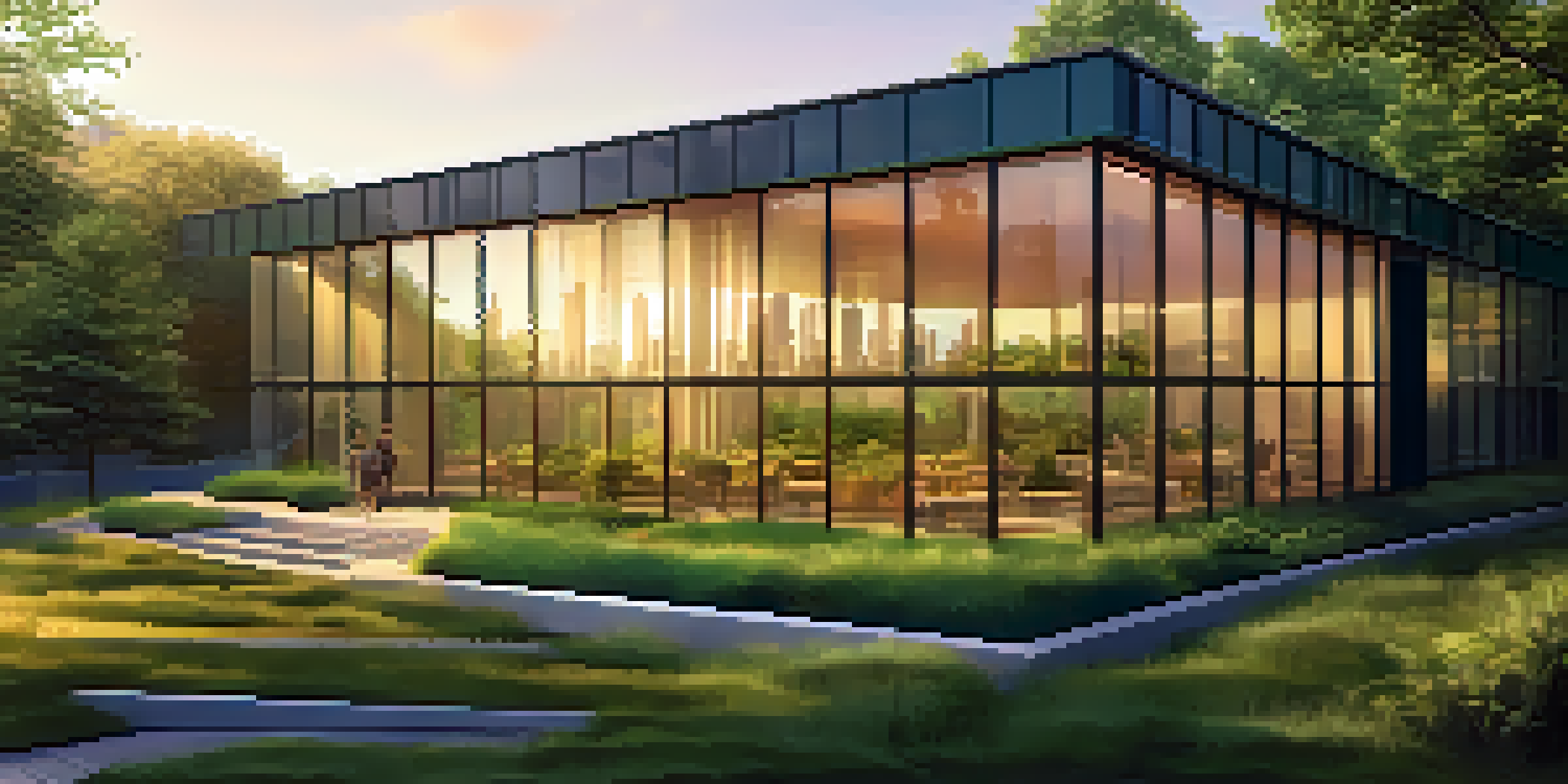Sustainable Architecture in Chicago: Green Building Trends

The Rise of Sustainable Architecture in Chicago
Sustainable architecture is more than just a trend in Chicago; it's a movement toward a greener future. With increasing awareness about climate change, architects and builders in the city are prioritizing eco-friendly practices. This shift is not only beneficial for the environment but also enhances the quality of life for residents.
Sustainability is not a trend, but a way of life that is essential for the future of our planet.
In recent years, Chicago has seen a surge in green buildings, thanks to initiatives like the Chicago Green Building Ordinance, which promotes environmentally friendly construction. This ordinance encourages developers to integrate sustainable materials and technologies, reflecting the city's commitment to reducing its carbon footprint.
As a result, buildings across the city are designed to harness natural light, improve energy efficiency, and use renewable resources. Chicago is becoming a beacon of sustainable architecture, inspiring other cities to follow suit.
Key Green Building Certifications in Chicago
One of the most recognized green building certifications is LEED (Leadership in Energy and Environmental Design). Many Chicago buildings are actively pursuing LEED certification, which ensures they meet rigorous environmental standards. This certification not only improves the building's sustainability profile but also increases its market value.

Another notable certification is the Living Building Challenge, which goes a step further by requiring buildings to be self-sufficient and produce more energy than they consume. Chicago's commitment to such high standards showcases the city's dedication to pushing the boundaries of sustainable design.
Chicago Leads in Sustainable Design
The city is prioritizing eco-friendly architecture through initiatives like the Chicago Green Building Ordinance and innovative design practices.
These certifications serve as benchmarks for architects and developers, encouraging them to adopt innovative techniques and materials that promote sustainability. By striving for these accolades, Chicago is setting a high bar for sustainable architecture.
Innovative Materials in Green Building Design
The choice of materials plays a crucial role in sustainable architecture. In Chicago, architects are increasingly using reclaimed wood, recycled metals, and low-VOC (volatile organic compounds) paints to minimize environmental impact. These materials not only reduce waste but also contribute to healthier indoor air quality.
The greatest threat to our planet is the belief that someone else will save it.
For instance, many new buildings incorporate green roofs, which are covered with vegetation that provides insulation and absorbs rainwater. This not only helps to manage stormwater runoff but also reduces the urban heat island effect common in cities like Chicago.
By opting for innovative materials, architects can create structures that are both aesthetically pleasing and environmentally responsible. This mindful approach to material selection is pivotal in shaping the future of sustainable architecture.
Energy Efficiency: A Core Principle of Green Buildings
Energy efficiency is a cornerstone of sustainable architecture, and Chicago is leading the charge with cutting-edge designs. Many buildings now feature advanced insulation, energy-efficient windows, and smart systems that optimize energy use. This not only reduces operational costs but also lowers greenhouse gas emissions.
For example, the Edgewater Library is designed with energy-efficient systems that utilize natural ventilation and daylighting, significantly reducing its reliance on artificial lighting and heating. Such innovations demonstrate how energy efficiency can be seamlessly integrated into building design.
Key Certifications Drive Standards
Certifications like LEED and the Living Building Challenge set rigorous environmental benchmarks for architects and developers in Chicago.
By prioritizing energy efficiency, Chicago's architects are not only enhancing the livability of buildings but also contributing to the city’s broader goals of sustainability and resilience against climate change.
Water Conservation Strategies in Chicago's Green Buildings
Water conservation is another critical aspect of sustainable architecture, and Chicago is embracing various strategies to minimize water usage. Many new buildings are outfitted with rainwater harvesting systems, which collect and reuse rainwater for irrigation and non-potable uses. This significantly reduces the demand on the municipal water supply.
Additionally, the city encourages the use of drought-resistant landscaping, which requires less watering and maintenance. This not only conserves water but also creates beautiful green spaces that enhance urban biodiversity.
By incorporating these water-saving techniques, Chicago's sustainable buildings are paving the way for a more responsible approach to water use, ensuring that this precious resource is preserved for future generations.
Community Engagement and Sustainable Design
Sustainable architecture in Chicago isn't just about buildings; it's also about community. Engaging local residents in the planning process ensures that new developments meet the needs of the community while also addressing environmental concerns. This collaborative approach fosters a sense of ownership and responsibility among residents.
Projects like the Chicago Riverwalk exemplify this community-focused design, providing public spaces that promote environmental awareness and social interaction. By creating spaces that encourage community engagement, architects are contributing to the overall health and well-being of the city.
Community Involvement Enhances Design
Engaging local residents in the planning process fosters a sense of ownership and ensures developments meet community needs.
Involving the community in sustainable design not only enhances the livability of spaces but also strengthens social ties, making Chicago a more connected and vibrant place to live.
The Future of Sustainable Architecture in Chicago
As we look to the future, the potential for sustainable architecture in Chicago is limitless. With ongoing advancements in technology and a growing commitment to environmental stewardship, the city is poised to become a global leader in green building practices. Architects are continually exploring new ideas and materials that challenge conventional design.
Moreover, Chicago’s focus on resilience and sustainability addresses the pressing challenges of climate change and urbanization. By prioritizing green infrastructure, the city is not only preparing for future challenges but also enhancing the quality of life for its residents.

The future is bright for sustainable architecture in Chicago, as the city embraces innovation, community involvement, and environmental responsibility.